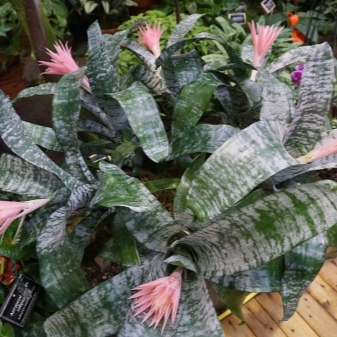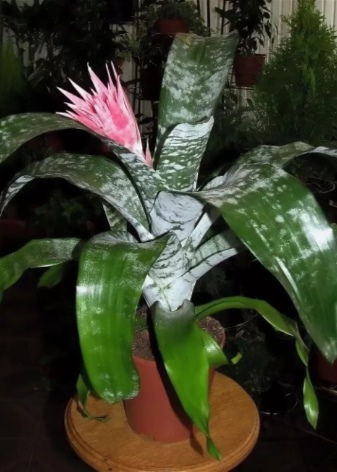Ehmeya striped: description, care and reproduction

It is quite difficult to surprise passionate lovers of indoor plants with anything when choosing vegetation for their home. But still there is one safe option - striped echmea (fasciata). And its kind - ehmeya "Primera".

Description of the plant
Aechmea literally translates from Greek as "tip of the peak". The appearance of the plant is fully consistent with its name.
This representative of bromeliads is not the only one in this genus, there are more than 180 species of them. Their main location is South and Central America. The plant's favorite habitat is the trunks of dilapidated trees, dried up large branches, dried stumps. Ehmeya can often be found in rocky and rocky areas.



In the arsenal of the bromeliad family there are many beautiful flowering representatives. Ehmeya is one of the most notable and original species.
Ehmeya striped and its variety - Ehmeya "Primera" are suitable for growing in the house. Gourmet florists love this plant for its decorative leaves and for the exotic look of the flower itself.
For the sake of contemplating beauty during the flowering period, I want to care for and cherish ehmeya. Although it blooms only once in a lifetime. For daily admiration and admiration for these flowers, you cannot neglect the elementary rules of care.


Home care
Light
When choosing a place of residence for ehmei, it is advisable to stay on a windowsill, the window of which faces west or east. The plant feels comfortable both in a well-lit place and in the shade. The main condition is to protect ehmeya from direct hot sunlight.
OA great option in the warm season is to put the flower in the fresh air: balcony, porch or area in front of the house. You just need to be careful with the first long stay, you need to control the behavior of the flower. And it is most correct to accustom to outdoor conditions gradually, otherwise the scorching sun will leave its mark on the foliage.
It is advisable to adhere to the same rule if the weather is not sunny, the cloudy atmosphere can also negatively affect. Only not from the heat, but from the humidity, the flower can begin to wither.


Temperature
Given the origin and residence in the tropics, ehmeya is a thermophilic plant and is not at all afraid of changes in temperature. A comfortable home atmosphere is quite favorable for her. The only prerequisite is to provide a regular supply of fresh air. Constant airing allows you to grow fully and feel satisfactory. If you follow the established recommendations for the temperature range, then the ideal indicator is + 20-27 ° Celsius.
Winter for Ehmei is a time for sleep. During this period, it is advisable to choose a cooler place.

Watering features
The principle of water supply for the bromeliad family is the same. During spring and autumn, watering should be rich. First of all, you need to provide the outlet with water, and then water the soil itself. Although it is believed that the roots are a secondary feed, it is impossible to allow the earth to be dry. Closer to cold weather, it is necessary to reduce the amount of water and supply it directly to the roots. And if there is no urgent need, then just sprinkle the leaves.
The water used for irrigation should be given special attention. It cannot be hard and icy. It is necessary to make it a little warmer than room temperature. And it is desirable that it be defended.

It is important to remember one nuance. After the ehmeya has faded, pouring water into the outlet is strictly prohibited, since abundant watering can provoke the death of the flower.
It is advisable not to drive the plant into a frame with insufficient moisture. Therefore, at the time of the heating season, it is recommended to artificially create conditions: spray the leaves of the plant from a spray bottle with soft, settled water, or, alternatively, put the pot on a pallet filled with moistened pebbles.


Fertilizer
Ideal for feeding is a mixture for the bromeliad family. The special composition of this fertilizer contains all the necessary elements. It is advisable to use the mineral complex in liquid form. Ehmeya perceives it best of all. If it is not possible to purchase one, then you can take the standard version, only its composition in the solution must be reduced by 2 times. In spring and autumn, the procedure must be performed once every 2-3 weeks. In the fall, reduce to 1 time per month. In winter, even once every 6-7 weeks.


Reproduction
Ehmeya reproduces in two ways:
- seeds;
- "Kids".
The seed option is irrelevant and not always effective. In addition, the process of growing echmea from seeds is very long and difficult. And there is a possibility that the grown seedlings will not retain varietal characteristics. But if, nevertheless, the choice is made in favor of such a method, then you need to familiarize yourself with the sequence of actions.
The container in which it is decided to grow seeds must be filled with peat and fern roots. Plant the seeds and place the container in a warm, dark place. Visit periodically with watering and airing. After 3 months have passed, the seedlings need to be cut into the substrate, which will contain soil and leaves. After 12 months, the seedlings are transplanted into a substrate intended for adult plants.
During the year and thereafter, the recommended care rules must be followed.


Breeding method by "kids"... In the first weeks of spring, separate the leaf from the main plant, which in appearance is as ready as possible for an independent life. Plant the scion in a separate pot where it will soon take root. To prevent rotting at the cut site, it is necessary to sprinkle it with activated carbon powder.
Ehmeya needs a transplant every spring. The root system is underdeveloped, so the pot must be taken wide, but not deep. Put stones at the bottom of the pot, since the plant does not like when there is excess moisture in the soil. Pour soil complete with fertilizer onto the base from the drainage. Gently collect the leaves in a bunch and remove the echmeya from the old container without damage. Place the flower in the prepared pot and add the second part of the earth. Transfer the flower to a non-sunny place and water it only after 2-3 days.


Bloom
From May to October, this is the time for echmea to bloom. She blooms only once in her life, but after that she leaves herself a replacement - "baby", which is later transplanted into an individual pot. You don't need to do this right away. The "baby" must grow to at least half of the total height of her mother. And as soon as the process becomes complete and ready for independent life, only then can it be transplanted into a separate pot.
After the plant has bloomed, it is imperative to remove the withered part and continue leaving, as before, observing the basic requirements. Otherwise, this dried residue can lead to drying, and then the death of the entire flower as a whole.
There is one proven method for stimulating flowering. To do this, put 2-3 ripe apples in a plastic bag, place a pot in it. Tie tight and leave for 1-2 weeks. Flowering can be observed after 4 months.


The plant, which was grown by seed, will bloom only after 4 years. Ehmeya, multiplied by "children", will bear fruit after two or three years. The duration of flowering of echmea is several months. The main flowers will wilt faster than the bracts. When watering, do not get on it with water, so as not to shorten the time of its flowering. And after the bract has faded, it must be cut with scissors at the very root. And be sure to remove the water from the outlet, otherwise the decay process will begin.
It also happens that the deadline has come, but there are still no flowers. There are many reasons:
- the temperature was lower than expected;
- abundance or, conversely, lack of watering;
- lack of fresh air;
- too large dishes - ehmeya spent her energy on nutrition and growth of roots, but they did not remain at all for flowering;
- poor lighting.

External signs that cannot be ignored
The leaves take on a brown tint. This means that the plant is overflowing with water. It is necessary to free the outlet from the liquid and suspend watering. The same is the reaction of leaves to cold temperatures. You need to check if the flower is too cold. If the leaves have become soft, then watering is not enough, and you need to increase it. If dry tips appear on the leaves, the plant speaks of too dry air.
Improper care will not only aggravate the appearance, but can also contribute to the appearance of pests. The plant weakens and a favorable environment opens up for aphids and root worms, fungal and viral diseases.
Regular examination will help get rid of the infection at an early stage. Eliminate the pest with a special profile solution.

Ehmeya striped contains poison in its leaves. It can irritate the skin of the hands. On contact with the eyes, a burning sensation will begin. To avoid these troubles, it is necessary to use rubber gloves when replanting and leaving. And after finishing work, wash your hands thoroughly with soap and water.
Ehmeya is a diamond among many indoor plants. It looks graceful in a single copy against the background of the interior. But it is simply impossible not to notice her beauty on a par with her comrades-in-arms. Her gift is to bloom for a long time, this is a godsend for connoisseurs of beauty.


People are attracted by the exotic. Something unusual, not like everyone else, attracts florists. Ehmeya striped is an opportunity to enjoy flowering for a long period, while spending a minimum of effort to maintain the beauty of this royal plant.
Find out more in the video below.
























The comment was sent successfully.